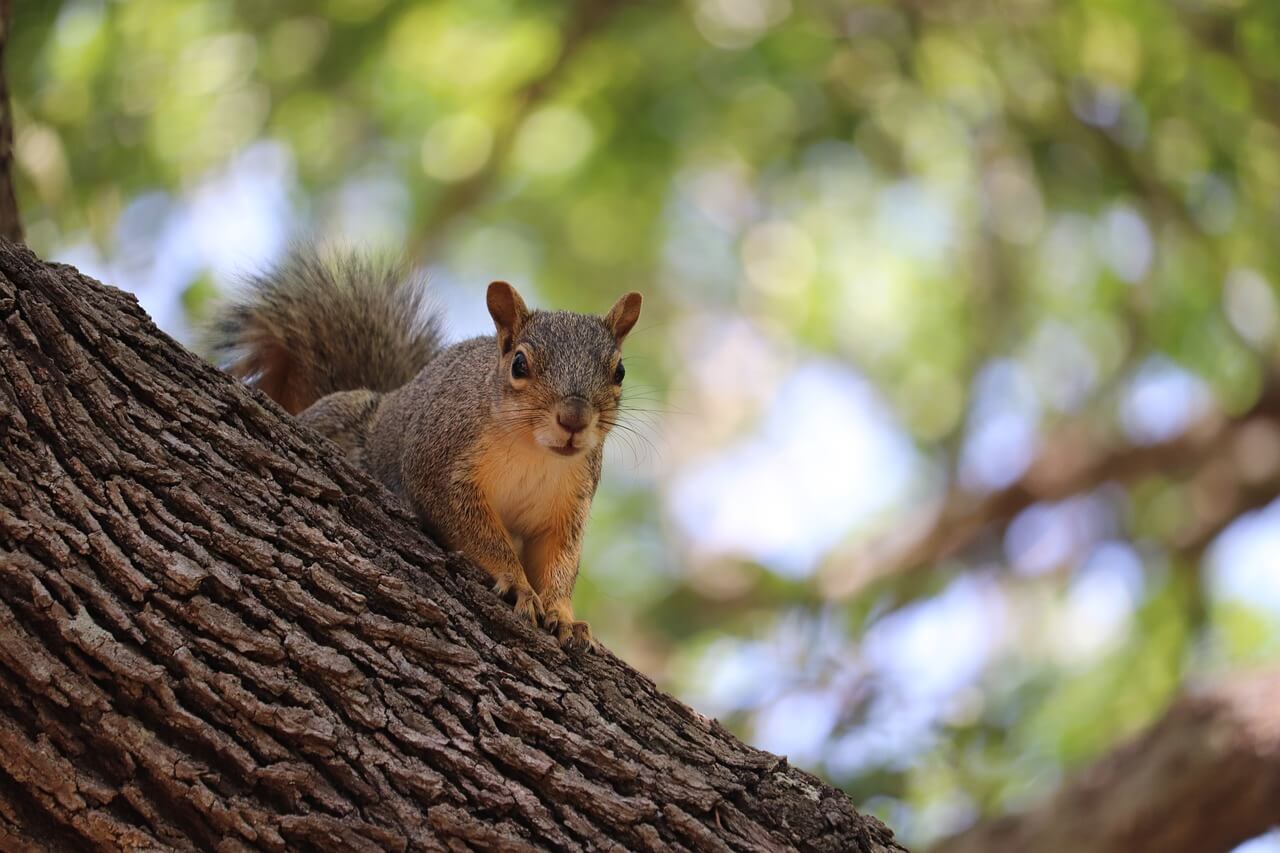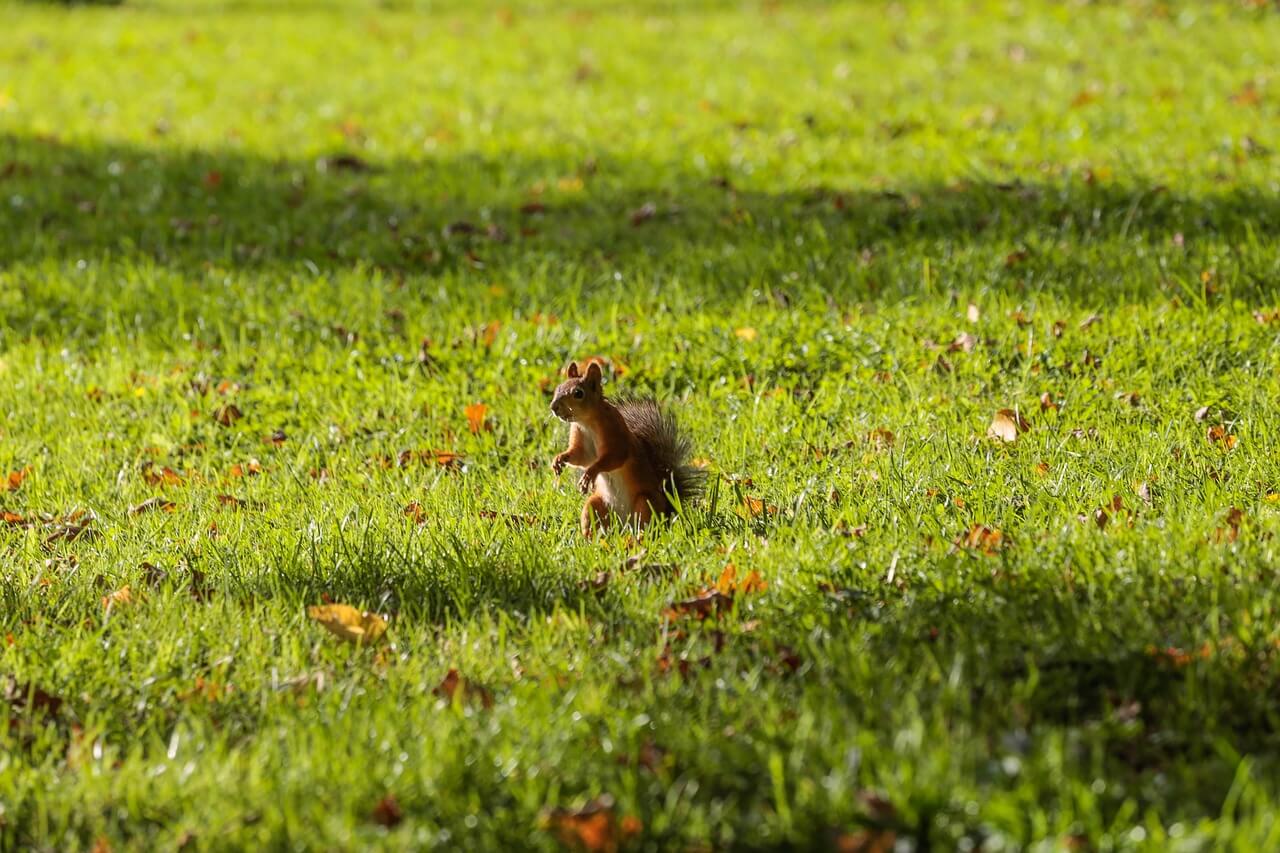Squirrels are a common sight in many backyards and forests around the country, and they may be snacking on more than just your bird seed. If you’ve been noticing chunks of bark missing or twigs being chewed off your maple tree, squirrels may be to blame. Read on to learn more about how to stop squirrels from eating your maple tree.
What You'll Learn Today
What are Squirrels Eating in My Maple Tree?

Squirrels rarely eat maple tree parts, but they love to “prune back” the new growth. They use both the bark and the small twigs to build their nests.
Squirrels may also use maple twigs and bark as chew toys. Their teeth need constant maintenance to keep them from growing too long, so this means they need to chew on things regularly.
If other food isn’t readily available, squirrels may peel back the outer bark and eat bits of the inner bark. They may also eat the buds, leaves, and samaras (seed pods) depending on how hungry they are.
Japanese maples seem to be the most popular species among the squirrel population. This is one of the smaller varieties of maple and, if too many squirrels invade the tree, it could easily be killed though having too much bark stripped away or too much new growth pruned back.
How Do You Stop Squirrels from Chewing on Trees?
If you’re having trouble with squirrels chewing on your maple trees, don’t despair. There are a few things you can do to discourage the local squirrel population from picking on your maple trees.
1. Give Them an Alternative
According to The Mercury News, it is possible to distract squirrels from your tree by leaving a pile of sticks, twigs, bark, or bedding material for them. Use nuts to attract them to the pile and away from your tree.
Of course, you will have to keep replenishing this pile to keep the squirrels coming back, and some homeowners may be concerned that this practice will actually attract squirrels to your property. Use your best judgment as to whether leaving a “peace offering” for the squirrels will work in your yard.
2. Use a Squirrel Repellent
There are various types of squirrel repellents on the market. Some are chemical sprays or pellets, while others make use of ultrasonic technology to scare the squirrels away.
You may even be able to use cayenne pepper and other spices as a repellent, as shown in the video below.
Regardless of the type of repellent you use, make sure you use it according to package directions. Some repellents may need to be reapplied continuously or may need regular maintenance.
3. Trim Branches Back
If you have trees growing near your house, powerlines, or fences, then squirrels may have easy access. Trimming branches away from these structures may make it more difficult for squirrels to get into your tree.
Try and keep branches back at least 4 or 5 feet from any nearby structures. This may be difficult or impossible with some trees, depending on where and how they are growing.
Be careful not to over prune your tree in an effort to keep the squirrels out. Pruning away too much of the tree will cause more permanent damage than most squirrels ever could.
Do Squirrels Live in Maple Trees?
Squirrels will build nests in any tree that they determine is sufficiently safe and offers convenient access to food and water. Considering their affinity for chewing on maple trees, there is a good chance they will choose your maple as their next home.
In general, having a few squirrels around will not pose a threat to your tree. Maple trees are not terribly fragile; as long as the squirrels don’t peel off too much bark or gnaw away too much of the new growth, you should have nothing to worry about.
That said, even a small amount of squirrel damage can affect the appearance of the tree, causing it to have “bald spots” or to sprout new growth in odd places.
So, if you don’t want your tree falling victim to the munching habits of squirrels, your best bet is to try and keep them from targeting your tree in the first place.
But how do you do that?
How Do You Protect Trees From Squirrels?

Squirrels are stubborn, tenacious, and acrobatic. It may prove difficult to keep them out of your maple trees completely, especially since maples tend to be their favorite kind of tree.
That said, if you’re trying to protect your trees from squirrels, there are several things you can do to discourage them from getting into your trees in the first place.
1. Hang Reflective Things in the Tree
Have you ever seen old CDs hanging from a tree? Squirrels and birds alike are repelled by the sudden flashing of any shiny object when it catches the light.
You can use old discs of any kind for this purpose, or you could use other objects such as disposable aluminum baking dishes, sparkly ribbon, small mirrors, or pieces of aluminum foil. The idea is to make sure they’re small enough to blow around in the breeze so that they catch the light and “flash” unexpectedly.
2. Wrap the Trunk in Metal Flashing
Metal flashing is an excellent squirrel deterrent. Not only will it reflect the light at certain times of the day, but it will prevent the squirrel from being able to climb up your tree trunks.
The flashing should be long enough to wrap loosely but securely around the trunk, with room to adjust it as the trunk grows. You’ll want to make sure the top of it is at least 5 feet off the ground.
Wrap the flashing around the trunk, making sure it isn’t so tight that it will suffocate the tree, but is tight enough so that squirrels won’t be able to slip underneath it. Secure the flashing with screws.
3. Use Gopher Wire
Gopher wire is similar to chicken wire except the spaces between the wire are much smaller. Wrapping your tree in gopher wire won’t completely prevent the squirrels from chewing, but they won’t be able to chew as much and may eventually become discouraged.
Gently wrap the gopher wire around the trunk, branches, and even smaller sticks and twigs. Cover as much of the tree as possible, being careful not to damage any new growth or wrap it too tightly.
4. Relocate the Squirrels
This may seem like an extreme option, but if you have too many squirrels hanging around your property, you may want to move some of them to a new home.
Bait a live animal trap with nuts and leave it near the tree. Anytime you catch a squirrel or two, take it to a wooded area some distance from your house and release the squirrels.
You may have to catch and release several times depending on how many squirrels you have. It’s best to do this in June and July, after baby squirrels born in the spring have left the nest and before fall babies are born.
Conclusion
Squirrels don’t usually eat maple except during food shortages, but they often chew on twigs and peel off chunks of bark. There are several things you can do to discourage this activity, such as hanging shiny objects from the tree, wrapping metal flashing around the trunk, and using squirrel repellent.
If there is only one small Japanese maple and hundreds of other nut-bearing trees around — a beech shedding nuts this year and dozens of red and white oaks with their acorns around — yet the squirrels are coming back repeatedly to the maple to chew, even within 30 minutes of being chased 100 yards away through a high canopy with a slingshot, then there is something beyond food shortage to their chewing. It is mostly likely a unique flavor to the sap, and boredom with the plain fare of acorns.
Trap the little vermin and move them onto the forest. They’re just trying to feed themselves. Are they a problem…yes. Outsmart them by trapping them.
I use 22 hollow points. They work the best. Then lay the body belly side up for the ravens and hawks to eat.
So guns are the answer? Jackass!
Relax Frankie we will just send all of our squrrels to your place
It’s part of mother nature, why not let them eat the bark and twigs? I heard they’ve been around here a while before us, +/- some million years ago.